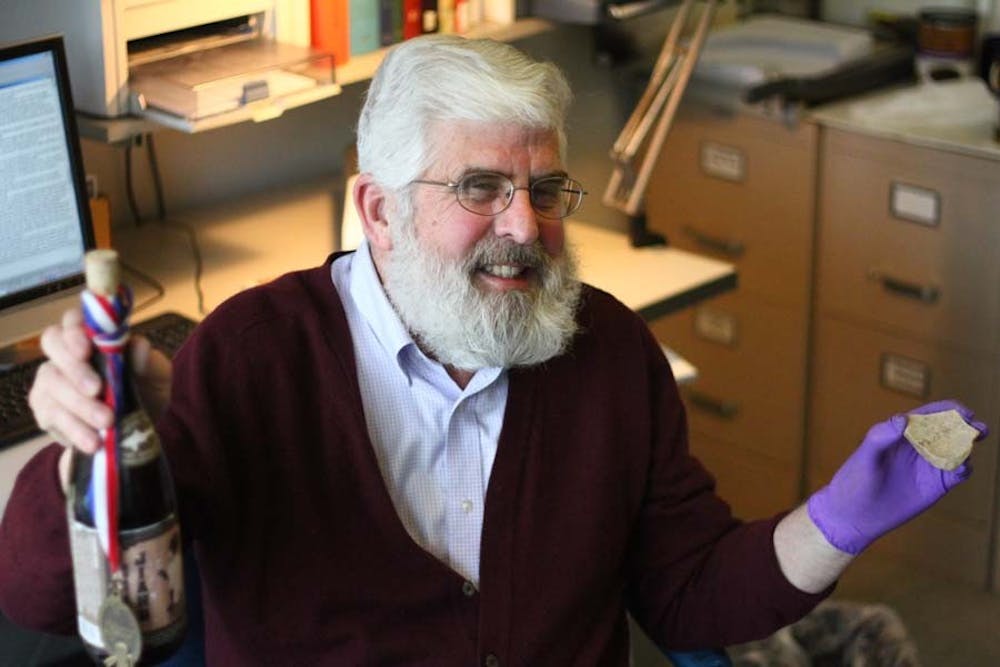
Every morning, Patrick McGovern bows down to beer.
In a small corner of his office in the University of Pennsylvania Museum of Archaeology and Anthropology, McGovern — sporting a neatly tucked-in maroon sweater along with his trademark white beard — is beginning his daily routine.
McGovern starts by reaching for a vessel that once held an ancient beer — the remnants of which are now sealed in a plastic bag on his shelf.
“It may be tough to believe, but what we’re looking at is around 9,000 years old,” McGovern says, explaining that what he’s holding is part of his “shrine” to ancient fermented beverages, which he looks at every morning.
McGovern then turns the clock forward a few thousand years, pulling out a black bottle with a tattooed Chinese woman on its label. The bottle holds a drink called “Chateau Jiahu” — a recreation of an age-old Chinese beer.
The woman’s tattoo, McGovern says, is the ancient Chinese symbol for alcoholic beverages.
“It’s the only Chinese pictogram that I know,” he jokes.
But for McGovern, it may just be the key to uncorking the stories behind some of the world’s oldest alcoholic beverages — drinks, he argues, that go a long way in tracing the history of human development.
***
Over the years, McGovern, the scientific director of the Penn Museum’s Biomolecular Archaeology Laboratory for Cuisine, Fermented Beverages and Health, has discovered some of the oldest fermented beverages known to man.
From barley beers from the Iranian empire to wines from France, McGovern is among the foremost researchers of ancient alcoholic drinks today.
Spending time with McGovern is somewhat like getting to know a hybrid of Louis Pasteur and Indiana Jones.
From just a few minutes with him, you can tell that McGovern’s upbringing has been as an academic. He speaks of his craft with a clear and technical precision, explaining that his field — called molecular archaeology — requires the utmost attention to detail.
At the same time, though, McGovern brings to the table an adventurous, Indiana Jones-like approach to his work. Over the past decade, he’s traveled thousands of miles across the globe, helping with dozens of excavations in his quest to track down the world’s oldest beers and wines.
“Our history as a human species is, in a lot of ways, the history of fermented beverages,” McGovern says. “Fermented beverages were right with us in the beginning, and they’ve had a lot to do with how we’ve developed over time.”
Speaking a few days after Spring Fling earlier this month, McGovern — who goes by “Dr. Pat” among some of his closest friends — says it wouldn’t be outside the realm of possibility that thousand-year-old cultures may have one day put on their own version of a “Fling.”
“Fermented beverages really are universal,” he says, explaining that both beer and wine have always been recognized culturally as a “mind-altering substance,” particularly at social gatherings like Fling. “They were a sort of universal medicine thousands of years ago, and they’re a universal medicine now.”
***
McGovern’s first experience in the world of ancient fermented beverages came around 1990, when he discovered an unusual grape wine and barley beer from an analysis of artifacts from the Zagros Mountains of Iran.
Soon after that, McGovern made one of his most significant discoveries yet — an ancient, Iron Age fermented beverage from the tomb of King Midas.
McGovern calls that discovery “the easiest excavation I’ve ever had to do,” since the vessel containing the drink had been brought to the museum in 1957 and had not yet been tested.
Through a complex chemical analysis of residue from the Midas artifacts, McGovern was able to deduce that the drink was, at one time, some combination of barley beer, grape wine, honey and mead.
McGovern wasn’t satisfied with that finding alone, however.
In 2000, he issued a challenge to a group of local brewers: to carry out experiments to see who could produce the most accurate modern-day replica of the Midas beer.
“A few months after I proposed that challenge,” McGovern says, “I had 25 sample microbrews sitting on my doorstep.”
The winner of the competition was Sam Calagione, the founder and president of Delaware’s Dogfish Head brewery, one of the fastest growing microbreweries in the country.
“That might have been one of the most expensive drinks I’ve ever made,” says Calagione, who used Muscat grapes, saffron and thyme honey in the initial brewing process.
Today, that recreation — called “Midas Touch” — is Dogfish’s single-most awarded beverage.
Including recreations like Midas Touch and Chateau Jiahu, McGovern has collaborated with Calagione — whose says his goal is to replicate the ancient tastes that people living thousands of years ago would have experienced — on six total brews.
“Dr. Pat’s brought a lot of scientific and academic expertise to these collaborations, in terms of his creativity and brewing prowess,” Calagione says. “It’s almost like he’s been able to create a liquid time capsule to bring those beers into the marketplace.”
***
McGovern is standing next to a glass-encased collection of artifacts that once belonged to Tutankhamun, the ancient Egyptian pharaoh.
The pottery is from around 1330 B.C. — a year that may seem ancient to the rest of us but, to McGovern, pales in comparison to some of what he’s found dating back to as early as 7000 B.C.
“He didn’t live long, but it looks like he was fond of drinking,” McGovern says of King Tut, examining a reddish-brown piece of pottery that he believes once held wine.
Today, much of McGovern’s time is spent in his Penn Museum lab, analyzing residue from vessels that researchers have sent him.
McGovern is something of a known commodity in the world of fermented beverage research today, with a group from Mexico even expressing an interest recently in sending him a sample of ancient distilled tequila for analysis.
“The work we do hasn’t really changed over the years, but the instrumentation has gotten far better,” says Gretchen Hall, who volunteers with McGovern in the lab at Penn. “Spending time with Pat has really taught me, and a lot of us, just how pivotal some of these drinks were in our earliest history.”
Although McGovern travels abroad less now than he did years ago, he recently returned from a trip to Denmark and Sweden, during which he recreated an ancient Nordic beverage.
Each of the trips he takes teaches him something new, he says.
“We’re always learning things that we never expected to come across,” McGovern says, carefully placing his bottle of Chateau Jiahu back onto the shelf. “We never really know where these experiments are going to end up, and that’s the greatest part of it.”
The Daily Pennsylvanian is an independent, student-run newspaper. Please consider making a donation to support the coverage that shapes the University. Your generosity ensures a future of strong journalism at Penn.
DonatePlease note All comments are eligible for publication in The Daily Pennsylvanian.







